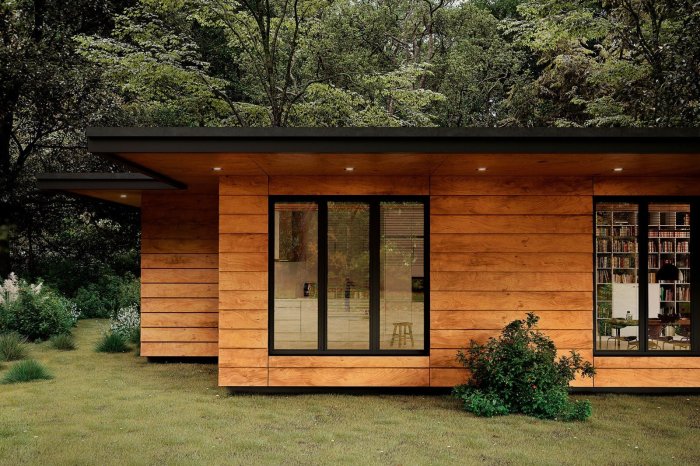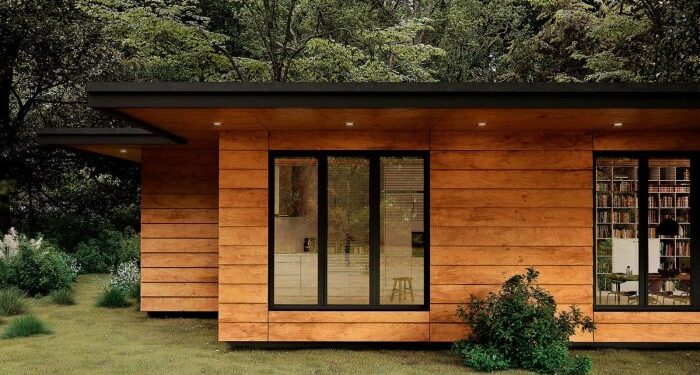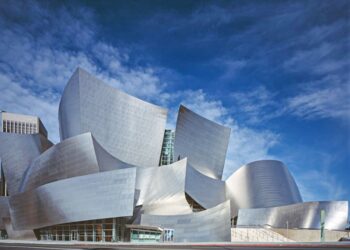Embark on a journey into the world of natural wood siding houses, where the timeless elegance of wood meets modern architectural design. Discover the charm and versatility that natural wood siding brings to homes, creating a warm and inviting exterior that stands the test of time.
Delve into the various aspects of natural wood siding, from its benefits to installation and maintenance, and unlock the secrets to enhancing your home's curb appeal with this classic material.
Benefits of Natural Wood Siding
When it comes to enhancing the exterior of your house, natural wood siding offers a range of benefits that make it a popular choice among homeowners.
Enhanced Aesthetics
Natural wood siding adds a warm and inviting look to your home, creating a timeless and classic appeal. The natural grains and textures of wood can complement various architectural styles, from traditional to modern, giving your home a unique and charming appearance.
Durability and Longevity
Contrary to common misconceptions, natural wood siding can be highly durable and long-lasting when properly maintained. With regular care and maintenance, such as staining or sealing, natural wood siding can withstand the elements and last for decades. In fact, some wood species like cedar and redwood are naturally resistant to rot, decay, and insect damage, making them a reliable choice for exterior cladding.
Types of Wood Suitable for Siding
When choosing wood for siding, it is essential to consider not only the appearance but also the maintenance requirements and environmental impact. Different types of wood offer various characteristics that cater to different needs and preferences.
Cedar
Cedar is a popular choice for wood siding due to its natural beauty, durability, and resistance to decay and insects. It has a warm, reddish-brown color that can be maintained with regular staining or painting. Cedar requires minimal maintenance compared to other types of wood, making it a cost-effective option for siding.
However, cedar may be more expensive initially than other wood types.
Pine
Pine is another commonly used wood for siding, known for its affordability and availability. It has a light color with a straight grain pattern, giving it a more uniform appearance when painted or stained. However, pine is not as durable as cedar and may require more frequent maintenance to prevent rot and insect damage.
Proper sealing and finishing are crucial to prolong the lifespan of pine siding.
Redwood
Redwood is a high-end option for wood siding, prized for its rich, natural tones and resistance to decay and insects. It is a durable wood that ages beautifully, developing a silvery patina over time if left untreated. Redwood is more expensive than cedar and pine, but its longevity and low maintenance requirements make it a worthwhile investment for homeowners looking for premium siding material.
Environmental Impact
When considering the environmental impact of choosing specific types of wood for siding, it is essential to look at factors such as sustainability, sourcing, and chemical treatments. Opting for sustainably sourced wood from certified forests helps reduce deforestation and supports responsible forestry practices.
Additionally, choosing wood that requires minimal chemical treatments or finishes can lower the environmental footprint of wood siding installation. By selecting environmentally friendly wood options, homeowners can contribute to conservation efforts and promote eco-friendly building practices.
Installation Process
Installing natural wood siding on a house requires careful planning and attention to detail. Here is a step-by-step guide to help you through the process.
Surface Preparation
Before installing natural wood siding, it is essential to prepare the surface properly. This includes cleaning the area to remove any dirt, dust, or debris. Ensure that the surface is smooth and free of any imperfections that could affect the installation process.
Proper Sealing and Finishing Techniques
Once the natural wood siding is installed, it is crucial to seal and finish it properly to protect it from the elements. Proper sealing helps prevent moisture damage, rot, and insect infestation. Additionally, finishing techniques such as staining or painting can enhance the appearance of the wood and prolong its lifespan.
Maintenance and Care
Proper maintenance is essential to ensure the longevity and beauty of natural wood siding. By following a regular care routine, you can prevent issues like rot, mold, and insect damage, and keep your siding looking its best for years to come.
Regular Inspections
- Inspect the siding annually for signs of damage, such as cracks, warping, or discoloration.
- Look for areas where water may be pooling or seeping behind the siding, as this can lead to rot.
- Check for any signs of insect infestation, such as holes or wood dust.
Preventing Issues
- Keep the siding clean by regularly washing it with a mild detergent and water to remove dirt and grime.
- Ensure proper ventilation to prevent moisture buildup, which can lead to mold and rot.
- Trim back trees and bushes near the siding to prevent damage from branches rubbing against the wood.
Cleaning and Refinishing
- For routine cleaning, use a soft brush or cloth to gently scrub the siding with a solution of water and mild detergent.
- Rinse the siding thoroughly with clean water and allow it to dry completely before applying any finishes.
- Apply a protective finish, such as a stain or sealant, every few years to maintain the wood's natural beauty and protect it from the elements.
Cost Considerations
When considering natural wood siding for your house, it is essential to take into account the cost implications. Let's explore how the cost of natural wood siding compares to other siding materials and factors that can affect the overall cost.
Cost Comparison with Other Siding Materials
- Natural wood siding tends to be more expensive upfront compared to vinyl or fiber cement siding.
- However, the aesthetic appeal and natural beauty of wood can add significant value to your home, potentially increasing its resale value.
- While initial costs may be higher, the long-term benefits of natural wood siding can outweigh the upfront investment.
Factors Affecting Cost of Natural Wood Siding
- The type of wood chosen for siding can greatly impact the cost. Exotic hardwoods like cedar or redwood are more expensive than softer woods like pine.
- Installation costs can vary depending on the complexity of the project, the size of the house, and the experience of the contractor.
- Maintenance and upkeep costs should also be considered, as natural wood siding may require more frequent care compared to other materials.
Long-Term Cost Benefits
- Despite the initial investment, natural wood siding can be a cost-effective choice in the long run due to its durability and longevity.
- Properly maintained wood siding can last for decades, reducing the need for frequent replacements or repairs.
- The natural insulation properties of wood can also help lower energy costs over time, making it a more sustainable and cost-efficient option.
Last Recap

In conclusion, natural wood siding offers a unique blend of beauty, durability, and sustainability for homeowners looking to elevate their property's exterior. With proper care and maintenance, a natural wood siding house can remain a stunning centerpiece for years to come, making it a worthwhile investment for any architectural enthusiast.
Quick FAQs
Is natural wood siding eco-friendly?
Yes, natural wood siding is a sustainable choice as it is biodegradable and can be sourced from responsibly managed forests.
How often should natural wood siding be refinished?
It is recommended to refinish natural wood siding every 3-7 years, depending on the climate and exposure to elements.
Can natural wood siding be painted?
Yes, natural wood siding can be painted or stained to achieve different aesthetic looks and provide added protection against the elements.






